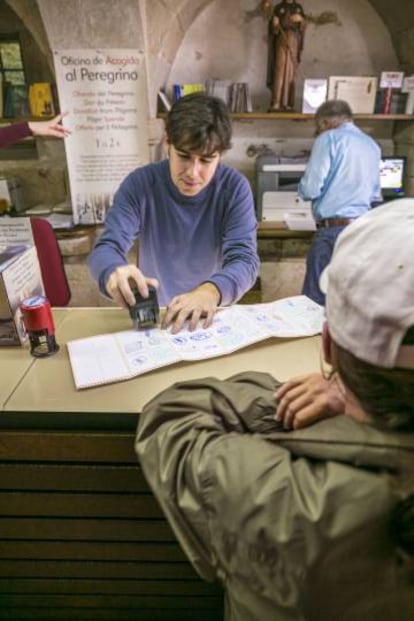Twelve things you didn¡¯t know about the Camino de Santiago
Do you know who the first pilgrim was on the world-famous Way of Saint James? Can you guess what the effect of the internet is on today¡¯s travelers? Read on¡

There is no better way to see the north of Spain than taking a trip west to Santiago de Compostela, following the yellow arrows that will eventually lead you to the tomb of the apostle Saint James the Great, whose remains are said to have been shipped there from Jerusalem.

Whether you choose to make the journey on foot, on horseback or bicycle, the hike through villages that ooze charm and history along the Camino de Santiago, or Way of Saint James as it is know in English, is a uniquely enriching experience. But just to make it even more fascinating, here are 12 things you probably didn¡¯t know about this famous pilgrimage route.
1. The original route
Legend has it that in the year 829, a shepherd stumbled across a tomb in a remote corner of Galicia. He got word to Bishop Teodomiro, who in turn passed on the news to King Alfonso II the Chaste, who then ruled the small isolated Christian kingdom of Asturias. The king decided to make the journey to see the tomb, which could potentially end the isolation of his kingdom. With his royal entourage, he walked what was then the only road from Oviedo to Galicia via Grado, Cornellana, Salas and the Port of Palo until he reached Galicia by A Fonsagrada. This route is now known as the Camino Primitivo as it is considered to be the original pilgrim¡¯s route to Compostela.
The Wine Fountain ¨Ca throwback to the Middle Ages when no pilgrim was refused a hunk of bread and a glass of wine
2. Is this the ¡®way¡¯ to Santiago?
There are in fact many different ways to Santiago. Since the discovery of the tomb, which supposedly held the body of Jesus¡¯s disciple, each pilgrim made his or her own ¡°way¡± from their home to Compostela. Some of these routes became more popular than others due to considerations such as safety or availability of food supplies, but there was never one that was singled out as the one. In 1993, UNESCO included the Way of Saint James on its list of worldwide heritage sites, and to simplify things the agency chose the French Way, which was and still is the most popular one. In 2015, UNESCO also listed the Routes of Northern Spain. But in reality the Camino de Santiago begins wherever your doorstep happens to be.
3. The rise of private accommodation
Useful links
If anything has changed in recent years ¨C particularly along the French Way ¨C it is the proliferation of private lodgings. It seems like almost every local resident has seized on the chance to turn their home into accommodation, and many of these establishments are more like typical backpacker hostels than the traditional albergues that used to be found along the way. In the town of Sarria, Lugo, there are no fewer than 30 establishments offering a bed for the night, 27 of which are private and seven of which line the main street, one after the other.

4. Organizing each leg online
The communal dining experience that once characterized the pilgrimage has been largely undermined by cellphones and Wi-Fi internet. ¡°Previously, people would share their experiences, but now they are more focused on their phones,¡± says one hostel owner with a hint of nostalgia. Technology has also altered the way reservations are made. Booking.com, emails and Facebook are widely used to book rooms, and there is a sense that a certain amount of spontaneity has been lost. There are even websites that will organize your entire itinerary. All you need is to say the number of days you wish to hike, and how much money you are willing to spend, and these start-ups will deal with your lodgings and luggage.

5. Pilgrim¡¯s certificate
The ¡®Compostela¡¯ is a document that certifies that you have completed the pilgrimage through devotionis affectu, voti vel pietatis causa ¨C through devotion, vows or piety, in Latin. This certificate is issued by the Pilgrim¡¯s Office on behalf of the Catholic Church, but your pilgrim¡¯s passport needs to show you have completed at least 100 kilometers of the route, either on foot or horseback, or 200 kilometers by bicycle. It is also important to say that the pilgrimage has been undertaken for religious reasons. For those whose motives lie elsewhere, there is a civil equivalent.
6. The pilgrim¡¯s bible
After the pilgrimage became popular again in the 1990s, a vast number of guide books and articles began to emerge on the subject, but all of them draw their knowledge from The Pilgrimages to Santiago de Compostela, penned by three medieval experts: Luis V¨¢zquez de Parga, Jos¨¦ Mar¨ªa Lacarra and Juan Ur¨ªa Riu. First published in 1948, this is a detailed history of the pilgrimage and everything associated with it, which fell out of print until the 1990s when it enjoyed a revival.
7. The first pilgrim
It is believed this honor belongs to Gotescalco, the bishop of Le Puy, who made the journey from Aquitaine in 950 accompanied by a sizeable entourage. That trip led subsequently to a flurry of pilgrimages from France, and not all of them a success ¨C in 961, a French nobleman named Raymond II, Marquis of Gothie, was mysteriously assassinated en route. Many centuries later, in 1668, an Italian prince named Cosme de M¨¦dicis embarked on one of the first documented tourist pilgrimages. Accompanied by 40 people, he visited Santiago and then sailed to the British Isles. There were also pilgrimages undertaken on behalf of others. In 1312, the Frenchman Yves Lebreton completed the journey in the name of the Countess of Artois.
8. The lost and found apostle
Fearing an attack on the tomb by the English ¡°pirate¡± Sir Francis Drake and his crew, Saint Clemente, the bishop of Compostela, hid the chest that supposedly held the remains of the apostle in 1558. Such was the genius of his hiding place, that it wasn¡¯t until 300 years later, in 1878, that workers came across it during refurbishments to the Cathedral of Compostela. Tucked behind the vault of the main altar were the remains of three males and, in 1884, Pope Le¨®n XIII issued a papal bull to embark on a four-year scientific investigation that ¡°proved¡± they belonged to the apostle and two of his disciples.

9. Wine on tap
Between Ayegui and the Irache monastery in Navarre, you come upon the famous wine fountain, a ¡°miraculous¡± tap that the Irache Bodegas maintains beside another that dispenses water, marking a custom from the Middle Ages when no pilgrim was refused a hunk of bread or a glass of wine. The fountain even has a webcam to film the pilgrims who drink from it.
10. Rebirth of the Camino
The traffic on the Camino de Santiago is breathing new life into towns and villages en route, including Foncebad¨®n, a locality in Le¨®n that lies close to Cruz de Fierro. In 1990, Foncebad¨®n had been reduced to a clutch of ruins. Now it has two restaurants, three private lodges, a parish lodge, a hostel and a supermarket. And almost all the houses along the main drag have been refurbished. So, just as it did during the Middle Ages, the Camino is proving an engine for growth.
11. Bridge of Honor
During the 15th century, pilgrimages on horseback became popular and one of the most famous episodes took place on the bridge over the River ?rbigo in Le¨®n, on the French Way. In July 1434, a knight from Le¨®n known as Suero de Qui?ones stood on the bridge and challenged other knights to cross it. For a month, Sir Suero and his men fought anyone who took up the challenge, losing only one man. After this act of bravado was over, the troop continued their pilgrimage to Santiago and the bridge became known as the Honorable Pass.

12. Who put all those yellow arrows there?
The yellow arrows that mark the route were put there during the 1980s when the Camino was still to come back into its own. Those responsible were El¨ªas Vali?a, the priest of O Cebreira, which is the first Galician parish on the French Way, and Andr¨¦s Mu?oz, a speech therapist from Navarre who is also the President of the Friends of the Camino de Navarra and who dedicated much of his life to improving and conserving the French Way. Subsequently, different associations from Friends of the Camino have made it their business to maintain and improve the route markers.
English version by Heather Galloway.
Tu suscripci¨®n se est¨¢ usando en otro dispositivo
?Quieres a?adir otro usuario a tu suscripci¨®n?
Si contin¨²as leyendo en este dispositivo, no se podr¨¢ leer en el otro.
FlechaTu suscripci¨®n se est¨¢ usando en otro dispositivo y solo puedes acceder a EL PA?S desde un dispositivo a la vez.
Si quieres compartir tu cuenta, cambia tu suscripci¨®n a la modalidad Premium, as¨ª podr¨¢s a?adir otro usuario. Cada uno acceder¨¢ con su propia cuenta de email, lo que os permitir¨¢ personalizar vuestra experiencia en EL PA?S.
?Tienes una suscripci¨®n de empresa? Accede aqu¨ª para contratar m¨¢s cuentas.
En el caso de no saber qui¨¦n est¨¢ usando tu cuenta, te recomendamos cambiar tu contrase?a aqu¨ª.
Si decides continuar compartiendo tu cuenta, este mensaje se mostrar¨¢ en tu dispositivo y en el de la otra persona que est¨¢ usando tu cuenta de forma indefinida, afectando a tu experiencia de lectura. Puedes consultar aqu¨ª los t¨¦rminos y condiciones de la suscripci¨®n digital.











































